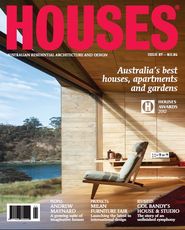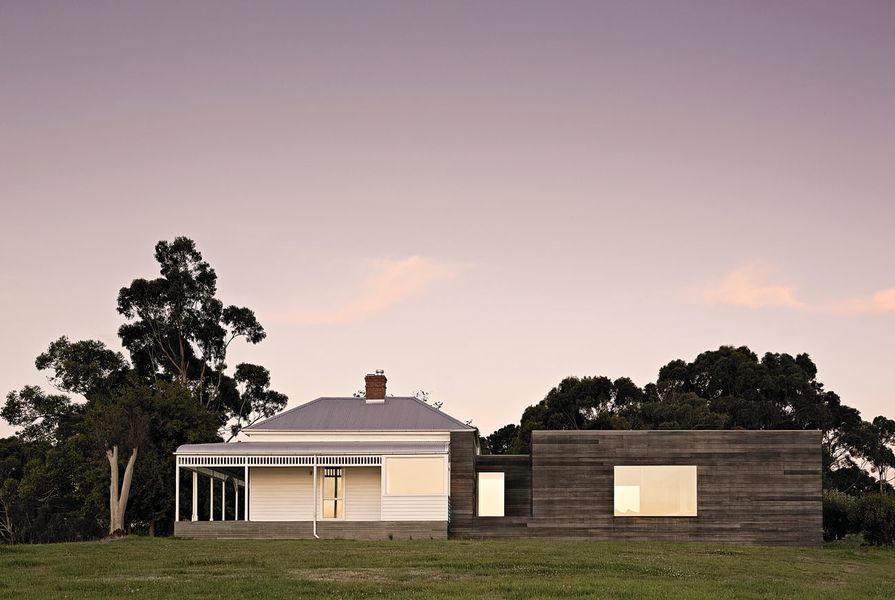The story behind the Courtyard House in Gippsland, Victoria, challenges assumptions that may – if this dwelling were to be judged on appearances alone – seem reasonable. The story is also a reminder of the benefits of taking time to do things, and the organic growth that can occur when a project is given ample time and space to germinate and flourish.
You could be forgiven for thinking this house was the product of a seasoned architect working with a high-end residential builder. In fact, it is the work of a young interior designer, Andrea Moore. She meticulously designed this house for her parents, who bravely acted as owner-builders for the ambitious project. The result is not only a stylish house, full of character, but a home that truly belongs to its owners.
Courtyard House is divided neatly into two parts: the “old house,” containing the bedrooms and a small sitting room and study combined; and the new pavilion, to the rear, containing the main living and utility areas and garage.
Spaces in the old house are generously proportioned.
Image: Lachlan Moore
The old house is generously, even grandly, proportioned, with lofty ceilings and a wide verandah. Interestingly, the original brief did not include plans to retain the old house. But when early investigations showed it to be structurally sound, if somewhat tired-looking, the project team decided that given its fine proportions, it was too great an asset to discard.
The decision to keep the old house proved pivotal in the evolution of this project. Indeed, says Andrea, the aesthetics of the project would be “completely different” without the old house in the mix, although she admits she has no idea what the alternative might have looked like.
The plan of the old house is a classic Foursquare with rooms arranged either side of a central hall. Beyond the bedrooms, the last space in the house is the “winter room” or “snug,” a combined study and sitting room with an impressive view out to the landscape.
Past the snug, the hall of the old house continues into the pavilion and down a single step that marks the transition into a very different kind of space. Separated from the old house by a channel of courtyard space, the new pavilion is built around an internal procession from the old to the new. The plan of the new pavilion flows in the shape of a question-mark, wrapping around a sheltered central courtyard that contains a single tree before terminating at the open kitchen.
The new pavilion wraps around a courtyard space.
Image: Lachlan Moore
The new pavilion is flooded with even light, which penetrates the interior through large sections of floor-to-ceiling glass. Most of the large glazing sections are sliding doors that can be open in good weather, affording the pavilion excellent cross-ventilation. The microclimate of the interior is further assisted by the thermal mass of its bluestone flooring, which helps keep the space cool in summer and retain warmth in winter.
It was not the bold minimalist form of the pavilion exterior that influenced its interiors. Rather, it was the other way around: the pavilion’s design has unfolded out of the experience of moving from one interior space to the next. Subtle level changes between the old and the new, and a syncopated rhythm of enclosure and opening, create a nuanced journey from the hall of the old house to the kitchen of the new pavilion. An important stopping point on that journey is the large picture window framing a view to the rolling Gippsland hills and horizon beyond.
Seen in this way, the house is clearly the work of a designer with interiors training. The difference between the thinking and sensibilities of architects and interior designers can be subtle, yet distinct. While an architect might have “charged” the project by playing off the discordant aesthetics and forms of the old house and the new pavilion, in Andrea’s hands the house focuses on clothing an unfolding interior. While the exterior envelope of the new pavilion is uncompromising, it is merely a consequence, secondary to the arrangement and quality of the spaces within. The result is idiosyncratic and refreshingly free of aesthetic ideology or dogma.
The story of the house would not be complete without reference to the skill of the owner-builders, who took on the challenge of constructing the house as well as some of the more significant pieces of furniture. The fine detailing of the project has been delivered with aplomb, and it is fair to say that the result is not what normally springs to mind when one hears the phrase “owner-builder.”
Almost six years in the making, Courtyard House is a true family home in every sense. It is tempting to describe the designer as an “emerging” talent, but fairer to say that with this project completed, she has well and truly emerged. I look forward to seeing what Andrea Moore does next.
Products and materials
- Roofing
- Lysaght Klip-lok roofing with Zincalume finish.
- External walls
- Local silvertop ash finished in custom profile.
- Internal walls
- Birch plywood joinery by Eco-Core; plasterboard, painted Dulux ‘Natural White’.
- Windows
- Steel-framed windows with matt black finish; Centor S1E Eco-Screen retractable flyscreens.
- Flooring
- Sawn bluestone.
- Lighting
- Toss B Cone and Toss B Sphere, from Hub Furniture.
- Kitchen
- Electrolux induction cooktop; Qasair rangehood; Miele integrated dishwasher; Bosch oven; Liebherr fridge.
- Bathroom
- Rogerseller Logic tapware; custom-made concrete bath.
- External elements
- Custom-milled Silvertop ash decking.
- Other
- Eco-Core White Birch Multiply joinery; dining table and beds by Studio Moore.
Credits
- Project
- Courtyard House by Studio Moore
- None
- Andrea Moore
- Architect
-
Studio Moore
- Consultants
-
Builder
Owner-builder
Cabinetry Leigh Wilson Kitchens
Engineer Deery Engineering
Lighting Ambience Lighting, Hub Furniture
- Site Details
-
Site type
Rural
Building area 311 m2
- Project Details
-
Status
Built
Design, documentation 18 months
Construction 24 months
Category Residential
Type New houses
Source

Project
Published online: 8 Nov 2012
Words:
Marcus Baumgart
Images:
Lachlan Moore
Issue
Houses, August 2012
























